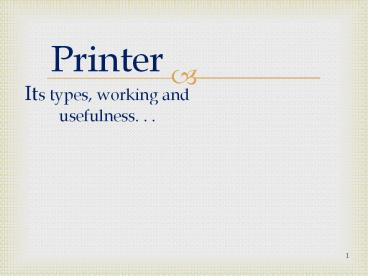Types of Printers - PowerPoint PPT Presentation
Title:
Types of Printers
Description:
Types of Printers – PowerPoint PPT presentation
Number of Views:72
Title: Types of Printers
1
PrinterIts types, working and
usefulness. . .
2
Printers
Impact Printers
Non-Impact Printers
Daisy wheel
Dot- Matrix
Inkjet
Laser
Thermal
3
What is a printer?
- An external hardware device responsible for
taking computer data and generating a hard copy
of that data. Printers are one of the most
commonly used peripherals and they print text and
still images on the paper.
4
Impact Printer
- These printers have a mechanism that touches the
paper to create an image. These printers work by
banging a print head containing a number of metal
pins which strike an inked ribbon placed between
the print head and the paper.
5
Non-Impact Printers
- These printers create an image on the print
medium without the use of force. They dont touch
the paper while creating an image. Non-impact
printers are much quieter than impact printers as
they dont strike the paper.
6
Dot Matrix Printer
- The term dot matrix refers to the process of
placing dots to form an image. - Its speed is usually 30 to 550 characters per
second (cps). - This is the cheapest and the most noisy printer
and has a low print quality. Dot Matrix were 1st
introduced by Centronics in 1970.
7
A typical dot matrix output
8
Advantages/Dis-advatages of Dot-Matrix
- Advantages
- (1) In-expensive.
- (2) Low per page cost.
- (3) Energy efficient.
- Dis-advantages
- (1) Noisy
- (2) Low resolution
- (3) Limited fonts flexibility
- (4) Poor quality graphics output.
9
Daisy Wheel Printer
- A daisy wheel printer is basically an impact
printer consisting of a wheel and attached
extensions on which molded metal characters are
mounted. A daisy wheel printer produces letter
quality print and it cant produce graphics
output.
10
Ink-Jet Printer
- It is a non-impact printer producing a high
quality print. A standard Inkjet printer has a
resolution of 300dpi. Newer models have further
improved dpi. Inkjet printers were introduced in
the later half of 1980s and are very popular
owing to their extra-ordinary performance.
11
How Inkjet Printer works?
- (1) Print head having four ink cartridges moves .
- (2) Software instructs where to apply dots of
ink, which color and what quantity to use. - (3) Electrical pulses are sent to the resistors
behind each nozzle. - (4) Vapor bubbles of ink are formed by resistors
and the ink is forced to the paper through
nozzles. - (5) A matrix of dots forms characters and
pictures.
12
Advantages/ Dis-advantages
- Advantages
- (1) High resolution output.
- (2) Energy efficient.
- (3) Many options to select.
- Dis-advantages
- (1) Expensive.
- (2) Special paper required for higher resolution
output. - (3) Time consuming in case of graphics printing.
13
Thermal Printer
- Thermal printers are in-expensive printers mostly
used in fax machines. The Thermal printers are
further classified into two types. - (1) Electro thermal printers
- (2) Thermal Wax printers
14
Laser Printer
- Laser printers use very advanced technology and
produce a high quality output. Laser printers can
also produce high quality graphics images. - Resolution is 600 to 1200dpi.
15
Multi-function printer
- A multi function printer abbreviated as MFP is an
all purpose device that prints, faxes, copies and
scans. A single multi function printer can
replace several bulky devices. A multi function
printer is also known as AIO. These printers use
inkjet technology and provide high quality print
but at slow speed.
16
Plotter
- A large scale printer which is very accurate in
producing engineering drawings and architectural
blueprints. - Two types of plotters are flatbed and drum.
- Flatbed plotters are horizontally aligned while
drum plotters are vertically positioned.
17
Conclusion
- In fact computer world is incomplete without
printers in the modern age of technology. A
printer is one of the basic needs of every
computer user and one can not utilize computer
resources properly in the absence of a quality
printer.
18
(No Transcript)































